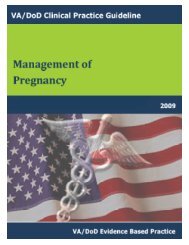DM Full Guideline (2010) - VA/DoD Clinical Practice Guidelines Home
DM Full Guideline (2010) - VA/DoD Clinical Practice Guidelines Home
DM Full Guideline (2010) - VA/DoD Clinical Practice Guidelines Home
You also want an ePaper? Increase the reach of your titles
YUMPU automatically turns print PDFs into web optimized ePapers that Google loves.
Version 4.0<br />
<strong>VA</strong>/<strong>DoD</strong> <strong>Clinical</strong> <strong>Practice</strong> <strong>Guideline</strong><br />
for the Management of Diabetes Mellitus<br />
• In another systematic review and meta-analysis, CSII resulted in better glycemic control as measured by<br />
HbA1c than MDI in patients with type 1 diabetes, and no statistically significant difference for patients<br />
with type 2 diabetes, with no difference in incidence of hypoglycemic events. (Jeitler et al., 2007)<br />
• A recent systematic review addressed the question of whether CSII benefits patients at high risk for<br />
hypoglycemia (whether CSII can help reduce incidence of hypoglycemia in such patients). For patients<br />
with type 1 diabetes CSII seemed to result in better glycemic control as measured by HbA1c than does<br />
MDI. Although trends favored CSII (less hypoglycemia), there was no significant difference in severe or<br />
nocturnal hypoglycemia between CSII and MDI. This review reported that pooled weighted mean<br />
difference in minor hypoglycemia favored MDI, but two of the three trials were in pediatric patients. The<br />
single study of adults with type 1 diabetes showed no significant difference (though trend was toward<br />
favoring MDI) (Fatourechi et al., 2009).<br />
• A meta-analysis of 22 studies in adults and children with type 1 diabetes published between 1996 and 2006<br />
showed a significant reduction in severe hypoglycemia compared with MDI. Although this analysis did not<br />
separate studies on adults from studies on children, there was a significantly greater reduction in severe<br />
hypoglycemia in older patients. Of note, there were no trials comparing CSII to MDI using newer longacting<br />
analogs where severe hypoglycemia could be analyzed (Pickup et al., 2008).<br />
• One systematic review studied quality of life issues in patients with type 1 diabetes on CSII (Barnard et al.,<br />
2007) One study (Tsui et al., 2001) of type 1 diabetes showed no differences between CSII and MDI with<br />
regard to QoL (glycemic outcomes not mentioned in the systematic review), while another (DeVries et al.,<br />
2002) showed improved glycemic control, general health status and health related QoL in patients with a<br />
long history of poor glycemic control.<br />
Type 2 Diabetes<br />
• A 24 week multicenter randomized parallel group study of 132 adults over age 35 with type 2 diabetes<br />
compared CSII with MDI therapy using NPH and aspart. Both groups achieved improvement in HbA1c,<br />
though there was no significantly significant difference between the two groups. Hypoglycemia was<br />
similar between the two groups. Patients using CSII were more satisfied with their diabetes management<br />
(convenience, flexibility, ease of use, overall preference) (Raskin et al., 2003).<br />
• In a 12 month randomized controlled trial of 107 adults over age 60 with type 2 diabetes, there was no<br />
advantage in the use of CSII over MDI, though both approaches achieved excellent glycemic control and<br />
were associated with high patient satisfaction (Herman et al., 2005).<br />
• A randomized crossover study (18 weeks for each treatment period) of 40 obese patients with type 2<br />
diabetes showed improved glycemic control by HbA1c with CSII compared to MDI as well as reduced<br />
mealtime glycemic excursions based on CGMS, but this study compared CSII using lispro with an MDI<br />
regimen using NPH and regular insulin (Wainstein et al., 2005).<br />
• Two reviews that included studies on type 2 diabetes showed no statistically significant difference between<br />
CSII and MDI with respect to glycemic control as measured by HbA1c and no difference in incidence of<br />
hypoglycemia. With respect to incidence of severe hypoglycemia, one review discussed that whether CSII<br />
can help reduce the incidence in patients at high risk for severe hypoglycemia has not been addressed since<br />
patients with prior severe hypoglycemia were excluded from the two trials that enrolled patients with type 2<br />
diabetes (Fatourechi et al., 2009, Jeitler et al., 2007).<br />
• There are no head-to-head comparisons of CSII and MDI regimens using glargine or detemir showing an<br />
improvement in the rate of severe hypoglycemia in patients with type 2 diabetes.<br />
Module G: Glycemic Control Page 66
















